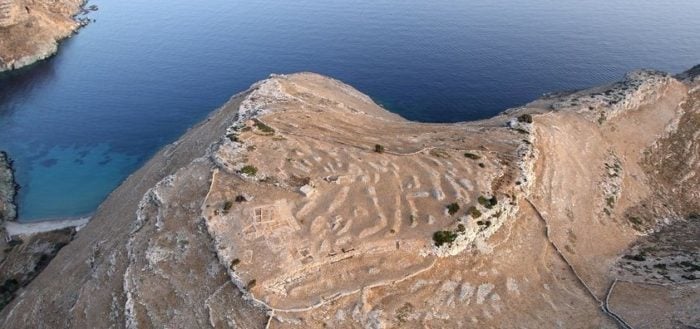Oldest City in Europe Is Strofilas in Greece: Η αρχαιότερη πόλη της Ευρώπης είναι ο Στρόφιλας στην Ελλάδα
Greek Reporter - January 21, 2023

The excavation of Strofilas, the oldest city in Europe, from above. Credit: Strofilas Excavation/Facebook
(O φίλος αναγνώστης Σταμάτης Τηνιακός που ζει στο Εδιμβούργο κι έχει σπίτι στις Μένητες στέλνει κατά καιρούς θέματα πολύ ενδιαφέροντα. Αυτή τη φορά βρήκε στο ελληνοαγγλικό σάιτ Greek Reporter μια σημαντική προβολή του Στρόφιλα της Άνδρου, της αρχαιότερης πόλης της Ευρώπης στα αγγλικά. Πηγές του δημοσιεύματος κείμενα της αρχαιολόγου Χριστίνας Τελεβάντου, που ανακάλυψε τον Στρόφιλα πριν 30 περίπου χρόνια και το Εν Άνδρω που με κείμενα, φωτογραφίες και ιδίως ένα βίντεο άνοιξε τον Στρόφιλα στον κόσμο. Ευχαριστούμε τον Σταμάτη Τηνιακό για την αποστολή του συνδέσμου από το αγγλόφωνο περιοδικό το κείμενο του οποίου αναδημοσιεύουμε εδώ μαζί με τις φωτογραφίες και το κείμενο. Για περισσότερες πληροφορίες στα ελληνικά αναζητήσετε "Στρόφιλας" στις "αναζητήσεις" του ιστότοπου μας - ΕΝ ΑΝΔΡΩ)
Strofilas, on the island of Andros in Greece, is the oldest city in Europe. Dating back to 4500 — 3200 BC, is the largest settlement of the Late Neolithic Age.
Strofilas was found almost intact in excavations conducted by a team of Greek archeologists, headed by Christina Televantou in 1997.
Located in the middle of the Aegean, on the edge of the Cyclades islands, the excavation on Andros sheds light on the area’s prehistory.
The findings show the largest and best-preserved, organized and densely populated settlement of the Neolithic Age in the Aegean.
A bridge between the Aegean and mainland Greece
Credit: Strofilas Excavation - Enandro You Tube
Based on the location, historians assume that Strofilas was a natural bridge between the Aegean islands and mainland Greece.
The characteristics of the island such as rich vegetation, water and arable land, made Andros hospitable and ideal for development; consequently it was the oldest city in Europe.
The remains of Strofilas reveal an organized social structure since the buildings show that the development of the island presupposes a collective effort.
The findings also give precious information on the art and metallurgy of the Neolithic, Early Cycladic and Middle Cycladic eras.
Early urban structures

Part of the Strofilas excavation. Credit: Christina Tselementou/Facebook
The fortification of Strofilas in Greece reveals early evidence of preserved defensive architecture, as the plethora of scattered finds from within and around the settlement shows.
The early urban and fortification structures are the oldest documented example of defense architecture with a gate and bastions. Its ruins betray a unique project that spans 30 acres, making it the oldest city in Europe.
Large buildings were discovered, featuring arches and quadrilaterals, of which remains of up to 1 meter (3.28 feet) high are preserved.
The largest part of the wall measuring about 100 meters (328 feet) long, which still stands up to 2 meters high; it is between 1.60 to 2 meters thick.
The 1.5-meter (4.92 foot) wide gate, which is protected by bastions, is 2,000 years older than the well-known Early Cycladic fortifications.
Also important finds such as pottery, stone tools, arrowheads, and obsidian spears, jewelry, figurines, and bronze objects show an advanced urban culture in this, the oldest city in Europe.
Finds of special value include the rock paintings that adorn the wall, the floor of the sanctuary and the rock along the wall.
The paintings depict animals, fish, spirals and more than 60 ships. This is an indication that there was pioneering development in shipbuilding at that time in the Aegean.
Also, some ships have a rhombus-like shape that apparently corresponds to a sail, something that may prove their early use in navigation.
The fact that some of the ships are depicted in formation, one after the other, and with specific banners, indicates that they may have had a single owner or that they sailed together in the Aegean, uniting different coasts and cultural identities.

Strofilas excavation: Covering the rock carvings. Credit: Facebook/Christina Tselementoy
Strategic location
The Cape of Strofilas is located in the center of the west coast of Andros in an extremely important strategic position which offered the ability to control a large area of the Aegean, from Attica and Evia to Syros, Paros and Naxos and the south part of the island.
In addition, as a natural stronghold, it can be accessed only from the mainland, therefore preventing assault by potential invaders.
In the southern part, there are two ports which provided safe harbor to ships, while the ravine provided drinking water. On the plateau lie the ruins of a settlement that appears to have been founded during what is known as the Late Neolithic Period I and flourished in the Late Neolithic II-Late Neolithic eras.
All the above features indicate that Strofilas is an archeological site unprecedented in size and preservation for its time.



